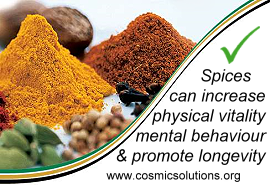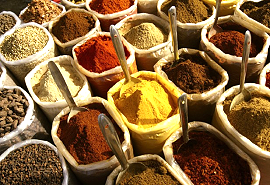Herbs and Spices
Preventative Agents Against Cancer [Malignant Neoplasm]

Herbs and Spices can counter the fundamental cause of cancer which is DNA damage - this can occur as a result of aging, genetic susceptibility, and exposure to an assortment of carcinogens.
Many of the phytonutrients found in spices act as potent preventive agents against cancer by defending DNA against free radicals and other toxins, preventing the overproduction of toxic chemicals within the body, assisting the body's detoxification processes and modulating a range of mechanisms involved in the development of cancer. In addition to reducing the risks of developing cancer, herbs and spices can also act as effective treatments for certain types of cancer. Some spices enhance the effects of the traditional cancer treatments of radiotherapy and chemotherapy, as well as reducing the negative side effects of these therapies.
The most important anti cancer herbs and spices are: anise, basil, black pepper, capsicum, caraway, cloves, cumin, fennel, garlic, ginger, mustard, rosemary, turmeric. Herbs and Spices are one of the vital keys to cancer prevention.
Cancer is a leading cause of death in most Western countries where, every year, hundreds of millions of dollars are allocated for research into new treatments. Eastern countries, where the incidence of most cancers is typically much lower, pour considerably less money into such investigations – and considerably more spices into their meals each year.
These humble herbs and spices, it appears, are exceptionally good value for money. A growing body of epidemiological and clinical evidence suggests that the most important factor contributing to the difference in cancer incidence between the West and many Eastern countries can be attributed to the noticeably higher levels of herb and spice intake.
In the USA, for example, the three most lethal cancers are those of breast, prostate and lung. In India, the incidence of these cancers – and of many others – is dramatically lower.
Cancer of the breast occurs eight times more frequently in American woman compared to their Indian counterparts - the incidence of prostate cancer in American men is more than 30 fold higher than in India - and the incidence of lung cancer is almost 20 times higher in the USA than in India.
As scientists continue to study an increasing number of spices, new evidence confirms that many of these foods, both individually and in combination, do indeed have strong anti-cancer properties.
By adding an average of 10 grams of spices a day to their meals, Indians, Sri Lankans, Thais and others are medicating themselves with some of the most powerful anticancer cocktails available.
Reducing our susceptibility to cancer is one of the most important measures we can take to increase our chances of good health. The following overview of the causes of cancer, the processes involved in its development and the multitude of ways in which phytonutrients act to combat it, shows that increasing our intake of spices is one of the most effective, convenient and economical ways in which we can fortify ourselves against this ubiquitous disease.
Causes of Cancer

Cancer is caused by a range of factors, most of which follow directly from – or are exacerbated by – the aging process. As a result, the probability of getting cancer increases exponentially as we grow older.
The wide-ranging biochemical and chromosomal changes associated with aging increase the risk of DNA damage, that is the first step towards developing a malignancy.
If our biochemical processes fail to repair the DNA or destroy the cells in which it is contained, the body's cancer-control mechanisms become ineffective and allow the unchecked proliferation of these abnormal pre-malignant cells. In addition to being less efficient at the repair and confinement of DNA damage, older bodies are less well equipped to protect cells against the agents that trigger the damage to our genetic coding material.
People of all ages can develop cancer, and youth is not guaranteed to protect against all carcinogenic factors. Among the most important of these are a genetic predisposition in the form of inherited oncogenes, exposure to environmental toxins, such as asbestos, petrochemicals, tobacco, alcohol, viral infections (such as the herpes and wart viruses) radiation, including sunlight's ultraviolet rays, chronic inflammation (such as that arising from autoimmune disorders) and the production of excessive quantities of harmful endogenous chemicals (such as hydrogen peroxide) by malfunctioning cellular processes.
Antioxidants and Free Radicals
These diverse carcinogens typically inflict their damage via free radicals. Once produced within our body or introduced into our systems, highly reactive and destructive free-radical particles circulate in search of something to react with, or oxidize. Targets of this damaging oxidative process include DNA that, when attacked by free radicals, can cease to send the correct signals needed to prevent uncontrolled cell growth. It is for this reason that antioxidants, which react with and neutralise free radicals before they can attack our body, are such valuable substances to include in our diets.
In addition to the many other anti-cancer properties found in herbs and spices, almost all of these foods contain powerful antioxidants which, when consumed regularly, mop up free radicals before they can initiate tumourigenesis.
Herb and Spice Compounds Fight Cancer

Herbs and spices are valuable preventative weapons against cancer not only for their antioxidant properties, but many of the phytonutrients contained in spices assist the body to detoxify and excrete carcinogenic compounds.
The value of spices is not limited to their ability to prevent the first step of cancer development, herbs and spices contain a number of powerful phytonutrients that act against pre-cancerous cells at each stage in their progression towards fully fledged tumours.
A mutation of the tumour-suppressor gene can result in its 'switching off' capacity being compromised - this results in defective DNA being passed on to each succeeding generation of cells, where these defects become enhanced and eventually result in the development of tumour cells.
The antioxidants in spices known to protect against cancer, notably those in ginger and turmeric, achieve this effect by preventing mutations in tumour-suppressor genes from occurring.
Nuclear Factor is a protein involved in cell survival, cell adhesion, inflammation and cell growth, and is an essential cog in the biochemical machinery that controls the growth and proliferation of normal cells. Its over-activation can be triggered by many of the carcinogens mentioned above, causing it to become an aggressive accelerator of tumourigenesis.
Extensive research in the last few years has shown that the pathway that activates this transcription factor can be interrupted by phytonutreints derived from herbs and spices including anise, basil, capsicum, clove, cumin, fennel, ginger, rosemary and turmeric.
Activated Protein (AP) is a molecule that, if produced in excess, stimulates the expression of several genes that enhance tumour proliferation, angiogenesis and tissue invasion. The effects of activated protein are blocked by compounds in turmeric. These same compounds also interfere with the stimulatory effect of estrogens on certain hormone-dependent tumours.
Autocrine loops are part of cancer cell cycle feedback mechanisms whereby the tumour cells release chemical messengers (cytokines) that, in turn, stimulate further tumour proliferation. Cytokines do this by stimulating growth factor receptors on other cells, which produce more cytokines that further accelerate these positive-feedback autocrine loops. Several compounds, including those found in mustard either block the cell receptors or the action of the cancer cell cytokines themselves thus curtailing these self-sustaining processes.
Radiotherapy and chemotherapy are widely used but imperfect treatments for cancer. Not only do they have serious debilitating side effects, but tumour cells often develop resistance to these therapeutic modalities. In addition to their intended destruction of cancerous cells, these therapies frequently activate NF-kappa beta, thereby contributing to the suppression of apoptosis and the promotion of tumour proliferation. You would be correct in thinking that obviously this is just the opposite of what one would expect from a cancer treatment.
Chemotherapy and radiotherapy also activate COX-2 enzymes, thus aggravating the inflammatory process that underlies many cancers. It has been discovered that several compounds found in consuming high quantities of turmeric reduce the activation of COX-2 and sensitize the tumour cells to both radiotherapy and chemotherapy, thereby enhancing their overall therapeutic effect.
Herbs and Spices - Preventative Agents Against Skin Cancer
Spices such as turmeric and mustard contain compounds that have recently been shown to protect against skin cancers. It is highly likely that many other spices and other phytonutrient-rich plant foods could provide protection against the damaging effects of the sun's rays. Skin cancers are the commonest cancers globally and by far the majority of these ubiquitous tumours are caused by excessive exposure to the sun.
The sun's ultraviolet rays (UVR) are those responsible for inducing several pre-malignant processes in the skin. Not only do they damage DNA directly but they also cause inflammation, excess free radical production and immunosuppression. These factors combine to form a tumourigenic cocktail that increases the risk for melanoma and non-melanoma skin cancers.
In spite of their potentially damaging effects UVRs also provide crucial health benefits - therefore it is important that the human skin is exposed to the sun for limited periods of time. The most important of these benefits is UVB rays' involvement in the production of vitamin D from dehydrocholesterol in the deep layers of the skin.
There is also evidence that a lack of exposure to the sun's rays is a significant factor in the development of diseases such as multiple sclerosis and certain malignancies other than skin cancer.
It is worth noting that the human body does attempt to prevent the accumulation of radiation damage and does so by initiating repair mechanisms at relatively low levels of radiation exposure. These processes involve both intrinsic and extrinsic (plant derived) antioxidants, enzymes and other protective plant based compounds and work in the following ways:
* Activation of mechanisms that counter free radical damage and oxidative stress.
* Acceleration of programmed cell death (apoptosis) of pre-cancerous cells.
* Activation of DNA repair mechanisms at low levels of radiation exposure.
There is a dichotomy in relation to UVR. On the one hand, in order to sustain normal physiological processes, we need a certain amount of exposure to the sun. However, if we are exposed to excessive amounts of UVR and have inadequate protective biological processes, we increase our risk for several different types of skin cancer.

It seems obvious that, as humans have lived for eons with constant exposure to the sun, our bodies would have adapted protective strategies to counter the damaging effects of UVR while still obtaining the benefits thereof.
We now know what some of these strategies are, but in order to understand how to enhance them, we need to take a look back over thousands of years at the vital role nutrient dense plant foods play in this regard.
Only a few thousand years ago our hunter-gatherer ancestors roamed, more or less naked, predominantly in the sun-drenched regions of the planet. Thanks to a more extensive ozone layer, they were probably exposed to slightly lower doses of UV radiation per unit of time than we are today. However they undoubtedly spent long periods of time in the sun while they hunted and collected plant foods. They also had dark skins that gave them an extra measure (but by no means complete) of protection against excessive UVR exposure. There is evidence that they lived well into their sixties and were therefore subject to significant UVR exposure for several decades.
The key to our forefathers' success in countering UVR damage was their consumption of a diet rich in phytonutrients. Owing to their active lifestyle, hunter-gatherer communities consumed a high calorific diet. The difference between their high calorie diet and a contemporary high calorie diet is that the former consisted largely of richly flavoured (spicy), phytonutrient-dense plant foods while the modern diet is dominated by relatively bland nutrient deficient plant foods.
The nutritional characteristics of the plants that hunter-gatherers consumed were different to ours in that they had far higher phytonutrient/calorie ratios to the plants we eat today. Those that are available nowadays are generally energy dense plant foods with much lower phytonutrient/calorie ratios.
There are two reasons for this. Firstly, we eat many grain based foods that have very high carbohydrate levels and relatively low phytonutrient levels. Secondly, over the centuries, we have bred varieties of most of our grains, fruit and vegetables that are far bigger, sweeter and starchier than they were in their natural state.
Add to this modern chemical farming methods and we now have plant foods with very low phytonutrient/calorie ratios that consist primarily of water and carbohydrates. These provide far fewer protective compounds than they did several thousand years ago. This translates into reduced intake of phytonutrients that, in adequate amounts, could protect us against UVR and other carcinogenic environmental factors.
The only food categories that have more or less escaped the plant breeders' attentions are the herbs and spices. Herbs and spices are the plant foods closest to those that our ancestors ate. They have extremely high phytonutrient/calorie ratios and contain large concentrations of a wide variety of powerful antioxidants and other protective nutrients.
Scientific Research
Recent scientific evidence has shown that several spices contain compounds that are very effective in countering UVR damage to the skin. These molecules possess the ability to act as direct and indirect antioxidants.
They have anti-inflammatory and immunomodulatory properties and can activate genes that control lasting protective processes against UVR damage. Scientists working in this field have also noted that multiple antioxidant compounds (found in phytonutrient-rich plants) have a better protective effect than high doses of single antioxidant supplements.
Spices known to have specific protective effects against radiation damage are:
Turmeric contains the anti-inflammatory, antioxidant, curcumin that has remarkable cancer fighting abilities against several cancers including melanomas.
Mustard contains sulphorafane, a non-antioxidant compound also found in cruciferous plants such as broccoli. Sulphorafane works by activating the body's intrinsic cellular defences against UVR and has been shown to counteract skin malignancies when used both internally and topically.
Curcumin and sulphoraphane are only two of the spice-based compounds that are currently being studied as possible treatments for a range of skin and other cancers. However, as spices provide a wide array of antioxidant and other protective compounds, it is highly likely that there are many more of them that can help us contain skin cancers as they undoubtedly did for our hunter-gatherer ancestors.
A combination of selective plant breeding, modern agricultural methods and poor dietary habits means that, without an injection into our diets of a significant quantity and variety of phytonutrient-rich foods such as herbs and spices, it is almost impossible to obtain the optimum quantities of protective plant compounds. Until we do so we will continue to see a rise in the incidence of skin cancers and other malignancies.
Herbs & Spices - Dietary Benefits
Herbs & Spices - Cardiovascular Disease & Stroke Prevention
Essential Anti Cancer and Cardio Protective - Herbs and Spices [long index]
Sitemap Menu
Associates
- Getting Healthy Staying Healthy
Get Motivated and Live Life Now - Deakin Better Health Channel
The Medicinal and Health Benefits - Global Health Information
Promoting Healthier Choices
Herbs & Spices
Anise is a Mediterranean spice that, in the West, is used mainly to flavour confectionery. In its native countries it is an important flavouring for alcoholic drinks like raki, ouzo and pernod. Traditionally it is used to treat coughs. Anise contains limonene which is known to have an inhibitory effect against a number of cancers.
It also contains eugenol which inhibits platelet aggregation. This makes it a valuable spice to take in the prevention of cardiovascular events such as heart attack and stroke."
Black pepper is derived from the fruit of a climbing vine native to southern India and Sri Lanka. White pepper is likewise made from this fruit but is processed differently. By increasing the bioavailability of other anti-tumourigenic spices such as turmeric, black pepper dramatically increases their potency and effectiveness against various types of cancer.
It also counteracts cancer development directly. Its principal phytochemical, piperine, inhibits some of the pro-inflammatory cytokines that are produced by tumour cells."
The flowers, seeds and roots of this herb are medicinally used in the treatment of liver disorders. About 30 to 60 ml of decoction of the flowers, seeds or roots can be used three times daily, with beneficial results, in the treatment of torpidity or sluggishness of the liver, biliary stasis or, stoppage of bile, jaundice and enlargement of spleen.
Endive or chicory juice, in almost any combination, promotes the secretion of bile and is, therefore, very good for both liver and gall bladder dysfunctions."
Cinnamon is a spice obtained from the bark of Cinnamomum zeylanicum, a tree that is indigenous to Sri Lanka and now cultivated in several other tropical countries too. Cinnamon is a powerful inducer of insulin sensitivity making it an effective treatment for both Type II diabetes and metabolic syndrome.
It has also been used as a traditional medicine to treat a variety of ailments including colds and digestive problems, as a perfume, and for flavouring wines."
In addition to their culinary uses, they have mild analgesic properties and oil of clove has long been used in dentistry as a treatment for toothache. Cloves are loaded with many highly effective antioxidants including procyanidin and quercetin that give this spice the distinction of having the highest antioxidant activity of all foods!
There is also evidence that eugenol and acetate inhibit platelet aggregation and thus protect against heart attacks and thrombotic strokes."
It benefits both liver and gall bladder in their vital role of handling fats within the body and aiding the detoxifying role of the liver. It is, therefore, useful in the disorders of these organs. Combined with the juice of watercress and with a diet without meat or much sugar and starch, it helps to make the liver and the gall bladder normal, and exercises a beneficial effect upon the nervous system.
Sufferers from hepatitis can generally benefit from dandelion tea."
In traditional medicine, it has been used to treat a number of conditions including diabetes, sore throats, and in poultices used to treat sores and abscesses. Recent investigations into the medicinal properties of this spice suggest it is important not only as a preventive for chronic diseases such as diabetes, but also for enhancing normal physiological processes, especially with respect to athletic performance.
Another one of its properties is the reduction of platelet aggregation which, in turn, dramatically reduces the risk of abnormal blood clotting associated with heart attacks and strokes."
Garlic, which is the bulb of a plant native to the Himalayas and Siberia, is among the world's most important spices. Used across the globe as pungent food flavouring, in many societies it is employed as an important medicinal spice with an array of traditional uses.
These include its use as an antiseptic, anti-asthmatic, anti-rheumatic and as a treatment for coughs and colds. Over the centuries, it has also been employed against specific disease scourges, notably leprosy, plague and smallpox."
Ginger is one of the most popular of all the spices and is derived from the root of a plant indigenous to Asia which is now cultivated across the globe for use in an enormous variety of foods, drinks and traditional medicines. It is used in folk medicine to treat colds and influenza and is an effective anti-emetic used in the treatment of both motion sickness, and the nausea and vomiting associated with pregnancy.
Numerous studies investigating ginger's medicinal properties have also shown it to be effective in the prevention and treatment of many of our more serious chronic degenerative diseases."
Mustard is native to the Mediterranean region is derived from several varieties of mustard plant, each of which produces seeds of a different intensity and flavour. Not only do they help to protect against a variety of malignancies, including cancer of the pancreas, prostate, breast, stomach and colon, but as little as two or three servings per month may be enough for their anticancer properties to take effect.
In addition to being valued internationally as a spice, it has a notable history of use in traditional medicines and has been used to relieve headaches, as an emetic, for colds and flu and to treat arthritis."
Nutmeg is the seed, and mace the aril, of a tree native to Indonesia. It provides several important antioxidants, including eugenol which inhibits platelet aggregation and oleanolic acid which can lower blood lipids and therefore help to prevent cardiovascular disease. Nutmeg also contains limonene which has preventive properties against some cancers, and linalool which has anticancer and antiviral effects.
In high doses it has narcotic effects and can induce hallucinations."
Turmeric's root is ground up to provide the yellow dye and flavoured powder known as haldi in India, and turmeric in the West. Turmeric's main constituent phytochemical, curcumin, is one of the most remarkable and most studied of all the spice compounds. In addition to its other medicinal properties, curcumin is an extremely valuable chemoprotective agent.
Much of the research and interest in curcumin has centred on breast cancer, but it has also been found to have protective effects against cancers of the bladder, stomach, uterus and cervix."
